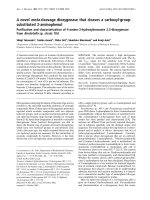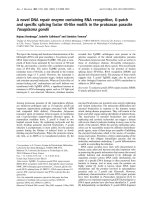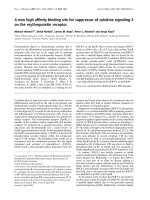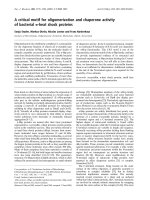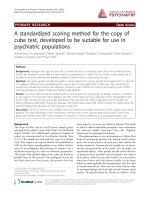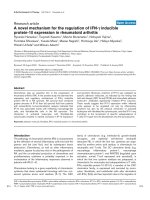Báo cáo y học: "A novel method for purifying bluetongue virus with high purity by co-immunoprecipitation with agarose protein A" ppsx
Bạn đang xem bản rút gọn của tài liệu. Xem và tải ngay bản đầy đủ của tài liệu tại đây (912.41 KB, 5 trang )
Zhen et al. Virology Journal 2010, 7:126
/>Open Access
METHODOLOGY
© 2010 Zhen et al; licensee BioMed Central Ltd. This is an Open Access article distributed under the terms of the Creative Commons
Attribution License ( which permits unrestricted use, distribution, and reproduction in
any medium, provided the original work is properly cited.
Methodology
A novel method for purifying bluetongue virus
with high purity by co-immunoprecipitation with
agarose protein A
Song Zhen
1
, Dong Changyuan*
1
, Wang Lulu
1
, Chen Dong-E
2
, Bi Guoming
1
, Dai Ming
1
and Liu Jun
1
Abstract
Background: Bluetongue virus (BTV) is an icosahedral non-enveloped virus within the genus Orbivirus of Reoviridae
and exists as 24 distinct serotypes. BTV can infect all ruminant species and causes severe sickness in sheep. Recently, it
was reported that BTV can infect some human cancer cells selectively. Because of the important oncolysis of this virus,
we developed a novel purifying method for large-scale production. The purifying logic is simple, which is picking out
all the components unwanted and the left is what we want. The process can be summarized in 4 steps: centrifugation,
pulling down cell debrises and soluble proteins by co-immunoprecipitation with agarose Protein A, dialysis and
filtration sterilization after concentration.
Results: The result of transmission electron microscope (TEM) observation showed that the sample of purified virus
has a very clear background and the virions still kept intact. The result of 50% tissue culture infective dose (TCID
50
)
assay showed that the bioactivity of purified virus is relatively high.
Conclusions: This method can purify BTV-10 with high quality and high biological activity on large-scale production. It
also can be used for purifying other BTV serotypes.
Background
Bluetongue virus (BTV) is an icosahedral non-enveloped
virus within the genus Orbivirus of Reoviridae [1] and
exists as 24 distinct serotypes [2]. BTV can infect rumi-
nant species mainly through the biting Culicoides species
[3]. Particularly, it usually causes severe bluetongue dis-
eases (BT) only in sheep and some species of deer. Over
the past century, BTV has never shown infectivity on
Homosapiens, and no normal human being cells have
been successfully infected by BTV [4].
The genome of BTV contains ten linear segments of
double-stranded RNA, and each of them codes one of the
viral proteins. The virion of BTV has two protein shells
with about 850-Å-diameter. The innermost shell is com-
posed of 120 copies of protein VP3 (about 103 KD),
which encloses three proteins (VP1, VP4 and VP6) and 10
segments of dsRNA genome, while the outer shell con-
sists of protein VP2 (111 KD) and protein VP5 (about 59
KD). The two shells are linked by 780 copies of protein
VP7 (about 38 KD) [5].
Protein VP2, coded by L2 segment, is the major cell
adhesion protein [6-8] and the most variable protein in
BTV. It can induce neutralizing antibody in the infected
host. On the basis of the antigenicity of protein VP2, all of
the 24 serotypes of BTV can be distinguished [9,10].
Besides, Protein VP5 helps to control the serotype of
BTV [11].
Recently, BTV-10 has been reported that it can infect
some human cancer cells selectively. The viral dose-
dependent cytopathic effect (CPE) can be effectively
induced by both virion amplification and virus-induced
apoptosis on human liver carcinoma cell line (Hep-3B)
and human lung carcinoma cell line (A549), while no visi-
ble CPE could be observed or detected in primary human
embryo lung fibroblast cell (HEL) even after 5th day post-
infection [4]. Another study about an unserotyped BTV,
which was isolated from Xiangfan, Hubei province of
china in 1990 and named BTV-HbC
3
, found that it can
cause apoptosis on Hep-3B cells and paraptosis on A549
cells [12]. Further more, in the in vivo test this strain can
* Correspondence:
1
Lab. of Molecular Virus & Cancer, State Key Laboratory of Virology, Wuhan
University School of Basic Medicine, Wuhan University, Wuhan 430071, China
Full list of author information is available at the end of the article
Zhen et al. Virology Journal 2010, 7:126
/>Page 2 of 5
make MA782-induced subcutaneously grown breast ade-
nocarcinoma significantly regressed in mice model [13].
There are many reports about the methods for BTV
purification, such as CsCl or saccharose density-gradient
centrifugation. But these methods could hardly produce
large amount of BTV virions and make BTV somewhat
degraded [14-16]. We developed an effective method for
high-throughput purifying BTV with high bioactivity,
which is very helpful for the study of BTV anti-tumor
effect since such studies need plenty of BTV with high
bioactivity.
Results
Purity and integrity of purified BTV-10 by transmission
electron microscopy (TEM)
The photographs from TEM observation showed both
unpurified (Fig. 1) and purified (Fig. 2) negatively stained
samples. In the photograph of unpurified virus, limited
amount of virions can be observed and they were sur-
rounded with a mass of cell debris (Fig. 1A &1B). On the
contrary, the photograph of purified sample revealed the
purity and integrity of virus. In fact, the virions can be
clearly observed in a clean background; meanwhile, the
purified viral particles were still kept intact (Fig. 2A &2B).
Biological activity test by TCID
50
assay
The biological infectivity of purified and unpurified BTV
was compared by the infectivity curvilinear trend and a
TCID
50
assay. Fig. 3 showed the process of 50% cells
exhibiting CPE as the infected time goes on according to
the number of wells, and as the curvilinear trend shown
the infectivity of purified virus is similar to the unpurified
virus. The TCID
50
was calculated at the seventh day when
the cells being infected. The TCID
50
of unpurified BTV
was 10
6.83
TCID
50
/ml and purified BTV was 10
6.42
TCID
50
/ml under the same conditions.
Discussion
Nowadays, the research on anti-tumor mediated by virus
is a hot field. Several viruses have been reported that they
can infect tumor cell lines obviously, such as Reovirus
[17] and Newcastle disease virus [18]. Over the past cen-
Figure 1 Transmission electron microscopy pictures of the unpu-
rified. The sample was a direct collection of the virus culture on Vero
cells. Picture A was photographed by digital camera and the virions
were marketed by arrows. Picture B was photographed by film and the
virions were marketed by arrows. In picture B, an empty shell was ob-
served. Cell debris was also clearly observed in the two pictures.
Figure 2 Transmission electron microscopy pictures of the puri-
fied. Picture A was photographed by digital camera and the virions
were marketed by arrows. The two-layer structure of BTV virion was
perfectly shown in picture A. Picture B was photographed by film and
the virions were marketed by arrows. In picture B, an uncoated BTV vi-
rion was observed and was marked by arrow.
Figure 3 The activity of purified and unpurified virus. The chart
graph shows the process of 50% cells exhibiting CPE as the infected
time goes on according to the number of wells. The unpurified virus
was used as a criterion to measure whether the purified virus was still
active enough. As the infecting days went by, the number of wells ap-
peared 50% CPE was increasing. The curvilinear trend of purified virus
is in accordance with unpurified virus, and the wells exhibiting 50%
CPE in purified virus per day is slightly less than that of unpurified virus.
Zhen et al. Virology Journal 2010, 7:126
/>Page 3 of 5
tury, BTV has never been reported infectivity on Homo-
sapiens, and no normal human being cells have been
infected by this virus. We have studied BTV on anti-
tumor for a long time and found that it can infect A549
and Hep-3B cell lines in vitro [4] and MA782 cell line in
vivo. However, further study needs a large amount of viri-
ons with high biological activities, and current virus puri-
fication method can not meet our needs of researching.
This study introduced a novel method for purifying
BTV-10 by cell debris co-immunoprecipitation with aga-
rose Protein A. The logic is pulling out all the compo-
nents unwanted, and then the left is what we want. The
whole process can be summarized as three purification
steps as well as one condensation and filtration steriliza-
tion step. The culture including Vero cells and the nutri-
ent medium, which is used to proliferate BTV, were used
as antigen to inoculate experimental rabbits in order to
acquire polyclonal antibody. These antibodies containing
various components were purified twice and then
absorbed by protein A formerly bounded on agarose. At
the same time, the culture mixture, containing lysed Vero
cells, was centrifuged so as to remove some cell apparatus
and big cell fragments. This step is very important and
can be regarded as the first step of purification. Then the
virus supernatant was mixed with the antibody-protein
A-agarose complex. In this second step, molecules and
cell pieces, which have antigenicity, have been pulled
down mostly, whereas BTV virions still kept in the super-
natant. But the second step is still not enough. In the
supernatant, there were still a mass of molecules with no
immunogenicity and those molecules that having antige-
nicity but did not induce immune response. So dialysis
was needed, as the third step, to remove these ingredi-
ents. Thanks to the diameter of BTV particles is 850Å, it
is safe enough to use dialysis tubing with 300 KD filtering,
which can effectively remove all of the left molecules.
After this third step, there were just BTV virions and
small amount of microorganisms left. And the final step
was the condensation of the virus solution by Polyethyl-
ene Glycol (PEG-20000) and sterilization filtration by 0.1
μ membrane filter.
The photographs about TEM observation on purified
virus showed clearly that the purified viral particles were
intact with a clear and clean background, while the unpu-
rified sample's photographs showed few virions that were
surrounded by a large amount of cell debris. This phe-
nomenon means the virions were successfully separated
from a mass of castoff.
Biological activity of purified viruses was tested by a
TCID
50
assay in Vero cells. Compared with unpurified
virus, the TCID
50
/ml of the purified fell slightly. This fall-
ing may be caused by filtration sterilization. Considering
that mycoplasma, which is a kind of potential pollutant in
purification process, can penetrate 0.22 μ filter mem-
brane, and the diameter of filter membrane we used for
sterilization is 0.1 μ, which is very close to the diameter of
a BTV particle, so as to avoid the purified virus contami-
nated by mycoplasma as much as possible. Unfortunately,
this step may cause virions loss.
The purification process completely focuses on how to
remove impurities with no regard to BTV serotypes,
which is just like centrifugation method but can avoid
physical injury on virions effectively. Thus it can be used
for all BTV serotype's purification and we have purified
several serotypes of BTV with this method (data not
shown).
Conclusions
After the above analysis based on the experiment, a new
BTV purification method with high quality and high bio-
logical activity was established, and this may significantly
push forward the research of BTV on anti-tumor and blu-
etongue sickness.
Methods
BTV-10 proliferation
BTV-10 and other serotype strains were acquired from
China Animal Health and Epidemiology Center. Vero cell
line was cultured in MEM (Gibco, USA) with 5% fetal
bovine serum at 37°C, 5% CO2. When cells formed
monolayer, culture medium was discarded and cells were
washed by Phosphate Buffered Saline (PBS) (50 mM PB,
100 mM NaCl, 1 mM EDTA, pH7.4) twice. Subsequently,
the monolayer of Vero cells were infected with 0.5 ml
BTV-10 suspension (10
5
TCID
50
/ml) and incubated at
37°C for 2 hours. After that, 6-10 ml MEM with 10% fetal
bovine serum was added, and cells were further incu-
bated at 37°C. When 90% cells appeared CPE, the culture
mixture was subjected to three rapid freeze/thaw cycles
by putting it into liquid nitrogen and 37°C water bath.
Then the virus-cell mixture (15 ml) was centrifuged at
5000 g for 10 minutes at 4°C and the supernatant was col-
lected. We took out 5 ml supernatant (virion-cell debris)
and preserved it at -20°C as control virus. The left virion-
cell debris suspension was centrifuged at 12,000 × g for 10
minutes at 4°C. And then the supernatant was harvested
and stored at -20°C. The uninfected cells were cultured in
the same conditions as the control, which were used for
producing polyclonal antibody either.
Preparation of Antibodies
The Vero cell-culture mixture was subjected to three
rapid freeze/thaw cycles by putting it into liquid nitrogen
and 37°C water bath. Following ultrasonication for three
1-minute cycles in ice-bath, the cell debris suspension
was centrifuged at 5000 × g for 10 minutes at 4°C. Subse-
quently, the supernatant was used as the antigen injected
into experimental rabbits to produce polyclonal antibody.
Zhen et al. Virology Journal 2010, 7:126
/>Page 4 of 5
The first inoculation was performed with 0.2 ml anti-
gen and Freund's incomplete adjuvant (FIA) mixture and
BCG vaccine (Bacillus Calmette-Guerin) to final concen-
tration of 10 mg/ml. 2 weeks later, the second inoculation
was performed the same dose. Then after 2 weeks, anti-
gen without Freund's adjuvant was inoculated 3 days con-
tinuously (once a day) with 0.1 ml, 0.2 ml and 0.3 ml
respectively as consolidating immunization. One week
later, the blood was collected from experimental rabbits'
heart and then the serum was harvested. The first purifi-
cation of the antibodies was precipitation by saturated
(NH
4
)
2
SO
4
. The sediment was resolved in 0.9% NaCl
solution and was dialyzed by PBS at 4°C and the dialysis
buffer was changed every 6 hours until the (NH
4
)
2
SO
4
was completely removed. The trace amount of (NH
4
)
2
SO
4
was checked by BaCl
2
solution. Then the polyclonal anti-
body was further purified by Montage
®
Antibody Purifica-
tion K with PROSEP-A media.
Purification of BTV-10 by Reverse Co-immunoprecipitation
with Agarose Protein A
2000 μl antibodies (2 mg/ml) were mixed with 3 ml aga-
rose Protein A completely and incubated at 4°C over-
night. Then the mixture was centrifuged at 1000 × g for
10 minutes at 4°C. The supernatant was discarded while
the deposit was collected and put into 10 ml unpurified
BTV-10 supernatant. The deposit, containing antibodies
and agarose Protein A, and BTV-10 suspension was incu-
bated at 4°C overnight. After incubation, the mixture was
centrifuged at 1000 × g for 10 minutes at 4°C.
Purification of BTV-10 by dialysis
Following the preceding step, the supernatant was trans-
ferred into dialysis tubing with 300 KD molecular weight
cutoff (MWCO) and was dialyzed by PBS at 4°C for 6
hours, which is one of the cell friendly buffers. Then, the
dialyzed solution is concentrated by PEG-20000 and
desalted by dialyzing at the same buffer again. This pro-
gram was repeated 4 times.
Transmission Electron microscopy assay
The purified BTV suspension was sterilized by filtration
using 0.1 μ membrane filter firstly. Then both of the puri-
fied and unpurified virus suspension were negatively
stained with 2% phosphotungstic acid. They were
observed by electron microscope to compare the purity
and integrity of viruses.
Identification of biological activity of purified viruses
BTV TCID
50
assay was used to test biological activity of
BTV in Vero cells. Vero cells were cultured in two plates
of 96 wells. When Vero cells formed monolayer, in one
plate, they were infected with the purified virus suspen-
sion formerly sterilized by filtration; in the other plate,
the cells were infected with the unpurified virus suspen-
sion. Both purified and unpurified virus suspensions were
diluted 10 times for six serial dilutions arrange from 10
-3
-
10
-8
. Each dilution was added to 12 wells with 100 μl/well.
Meanwhile 24 wells (F line and G line) of cells of each
plate were cultured as the control group. The two plates
were placed at 37°C with 5% CO
2
and CPE was observed
everyday for 7 days. And TCID
50
was calculated using
Karber formula.
Competing interests
The authors declare that they have no competing interests.
Authors' contributions
SZ carried out Preparation of Antibodies, dialysis, concentration, drafted the
manuscript and participated in TEM observation. DCY as the corresponding
author designed the idea of the method and participated in TEM observation.
CDE and WLL carried out the biological activity test, and WLL participated in
revising the manuscript. Bi Guoming carried out the Reverse Co-immunopre-
cipitation; DM and LJ carried out BTV proliferation. All authors have read and
approved the final manuscript.
Acknowledgements
This study was supported by National Natural Science Fund (No. 30772519).
Author Details
1
Lab. of Molecular Virus & Cancer, State Key Laboratory of Virology, Wuhan
University School of Basic Medicine, Wuhan University, Wuhan 430071, China
and
2
Dept. of Epidemiology & Health Statistics, Wuhan University School of
Public Hygienics, Wuhan University, Wuhan 430071, China
References
1. Pritchard LI, Gould AR: Phylogenetic comparison of the serotype-
specific VP2 protein of bluetongue and related orbiviruses. Virus Res
1995, 39:2-3.
2. Oldfield S, Hirasawa T, Roy P: Sequence conservation of the outer capsid
protein, VP5, of bluetongue virus, a contrasting feature to the outer
capsid protein VP2. J Gen Virol 1991, 72:449-51.
3. Wilson WC, Ma HC, Venter EH, van Djik AA, Seal BS, Mecham JO:
Phylogenetic relationships of bluetongue viruses based on gene S7.
Virus Res 2000, 67(2):141-51. Erratum in: Virus Res. 73 201-2
4. Jun H, Dong CY, Li KK, Chen DE, Liang K, Liu J: Selective in vitro cytotoxic
effect of human cancer cells by Bluetongue virus-10. Acta Oncol 2008,
47:124-134.
5. Nason EL, Rothagel R, Mukherjee SK, Kar AK, Forzan M, Prasad BV, Roy P:
Interactions between the inner and outer capsids of bluetongue virus.
J Virol 2004, 78:8059-8067.
6. Huismans H, Van Der Walt NT, Cloete M, Erasmus BJ: Isolation of a capsid
protein of bluetongue virus that induces a protective immune
response in sheep. Virology 1987, 61:3589-3595.
7. Mertens PPC, Burroughs JN, Anderson J: Purification and properties of
virus particles, infectious subviral particles, and cores of bluetongue
virus serotype 1 and 4. Virology 1987, 157:375-386.
8. Mertens PPC, Burroughs JN, Walton A, Welby MP, Fu H, O'Hara RS, Brookes
SM, Mellor PS: Enhanced infectivities of modified bluetongue virus for
two insect cell lines for two Culicoides vector species. Virology 1995,
217:582-593.
9. Roy P: Bluetongue virus proteins. J Gen Virol 1989, 73:3051-3064.
10. Cowley JA, Gorman BM: Cross-neutralisation of genetic reassortants of
bluetongue virus serotypes 20 and 21. Vet Microbiol 1989, 19:37-51.
11. Mertens PPC, Pedley S, Cowley J, Burroughs JN, Corteyn AH, Jeggo MH,
Jennings AM, Gorman BM: Analysis of the roles of bluetongue virus
outer capsid proteins VP2 and VP5 in determination of virus serotype.
Virology 1989, 170:561-565.
Received: 16 February 2010 Accepted: 13 June 2010
Published: 13 June 2010
This artic le is available fro m: http://www.v irologyj.com/co ntent/7/1/126© 2010 Zhen et al; licensee BioMed Central Ltd. This is an Open Access article distributed under the terms of the Creative Commons Attribution License ( which permits unrestricted use, distribution, and reproduction in any medium, provided the original work is properly cited.Virology Journal 2010, 7:126
Zhen et al. Virology Journal 2010, 7:126
/>Page 5 of 5
12. Chen J, Hu J, Dong CY, Liang K, Dai Y, Gao J: Death mode of Hep-3B and
A549 tumor cells induced by bluetongue virus strain HbC3. Zhonghua
Zhong Liu Za Zhi 2007, 29:505-9.
13. Xiang Luo, Changyuan Dong, Shufang Guo: Bluetongue Virus Therapy of
MA782 Breast Adenocarcinom a Grown Subcutaneously in Mice.
Volume 25. Medical Journal of Wuhan University; 2004:372-379.
14. Martin SA, Zweerink HJ: Isolation and characterization of two types of
bluetongue virus particles. Virology 1972, 50:495-506.
15. Verwoerd DW, Els HJ, De Villiers EM, Huismans H: Structure of the
bluetongue virus capsid. J Virol 1972, 10:783-794.
16. Huismans H, Els HJ: Characterization of the tubules associated with the
replication of three different orbiviruses. Virology 1979, 92:397-406.
17. Coffey MC, Strong LE, Forsyth PA: Reovirus Therapy of Tumors with
Activated Ras Pathway. Science 1998, 282:1332-1334.
18. Ahlert T, Schirrmacher V: Isolation of a human melanoma adapted
Newcastle disease virus mutant with highly selective replication
patterns. Cancer Res 1990, 50:5962-5968.
doi: 10.1186/1743-422X-7-126
Cite this article as: Zhen et al., A novel method for purifying bluetongue
virus with high purity by co-immunoprecipitation with agarose protein A
Virology Journal 2010, 7:126
